A Review of Current Regenerative Medicine Strategies that Utilize Nanotechnology to Treat Cartilage Damage
- PMID: 28217211
- PMCID: PMC5299562
- DOI: 10.2174/1874325001610010862
A Review of Current Regenerative Medicine Strategies that Utilize Nanotechnology to Treat Cartilage Damage
Abstract
Background: Cartilage is an important tissue found in a variety of anatomical locations. Damage to cartilage is particularly detrimental, owing to its intrinsically poor healing capacity. Current reconstructive options for cartilage repair are limited, and alternative approaches are required. Biomaterial science and Tissue engineering are multidisciplinary areas of research that integrate biological and engineering principles for the purpose of restoring premorbid tissue function. Biomaterial science traditionally focuses on the replacement of diseased or damaged tissue with implants. Conversely, tissue engineering utilizes porous biomimetic scaffolds, containing cells and bioactive molecules, to regenerate functional tissue. However, both paradigms feature several disadvantages. Faced with the increasing clinical burden of cartilage defects, attention has shifted towards the incorporation of Nanotechnology into these areas of regenerative medicine.
Methods: Searches were conducted on Pubmed using the terms "cartilage", "reconstruction", "nanotechnology", "nanomaterials", "tissue engineering" and "biomaterials". Abstracts were examined to identify articles of relevance, and further papers were obtained from the citations within.
Results: The content of 96 articles was ultimately reviewed. The literature yielded no studies that have progressed beyond in vitro and in vivo experimentation. Several limitations to the use of nanomaterials to reconstruct damaged cartilage were identified in both the tissue engineering and biomaterial fields.
Conclusion: Nanomaterials have unique physicochemical properties that interact with biological systems in novel ways, potentially opening new avenues for the advancement of constructs used to repair cartilage. However, research into these technologies is in its infancy, and clinical translation remains elusive.
Keywords: Arthroplasty; Biomaterials; Cartilage; Cartilage-tissue-engineering; Nanomaterials; Nanotechnology; Osteoarthritis; Tissue-engineering.
Figures
Similar articles
-
Nanotechnology biomimetic cartilage regenerative scaffolds.Arch Plast Surg. 2014 May;41(3):231-40. doi: 10.5999/aps.2014.41.3.231. Epub 2014 May 12. Arch Plast Surg. 2014. PMID: 24883273 Free PMC article. Review.
-
Targeting Polymeric Nanobiomaterials as a Platform for Cartilage Tissue Engineering.Curr Pharm Des. 2019;25(17):1915-1932. doi: 10.2174/1381612825666190708184745. Curr Pharm Des. 2019. PMID: 31298149 Review.
-
The Combination of Bioactive Herbal Compounds with Biomaterials for Regenerative Medicine.Tissue Eng Part B Rev. 2024 Dec;30(6):607-630. doi: 10.1089/ten.TEB.2024.0002. Epub 2024 Apr 12. Tissue Eng Part B Rev. 2024. PMID: 38481114 Review.
-
The triad of nanotechnology, cell signalling, and scaffold implantation for the successful repair of damaged organs: An overview on soft-tissue engineering.J Control Release. 2021 Apr 10;332:460-492. doi: 10.1016/j.jconrel.2021.02.036. Epub 2021 Mar 4. J Control Release. 2021. PMID: 33675876 Review.
-
Nanomaterials/Nanocomposites for Osteochondral Tissue.Adv Exp Med Biol. 2018;1058:79-95. doi: 10.1007/978-3-319-76711-6_4. Adv Exp Med Biol. 2018. PMID: 29691818 Review.
Cited by
-
Combinatorial Effect of Mesenchymal Stem Cells and Extracellular Vesicles in a Hydrogel on Cartilage Regeneration.Tissue Eng Regen Med. 2023 Feb;20(1):143-154. doi: 10.1007/s13770-022-00509-6. Epub 2022 Dec 8. Tissue Eng Regen Med. 2023. PMID: 36482140 Free PMC article.
-
Physico-Chemical Properties and Biocompatibility of Thermosensitive Chitosan Lactate and Chitosan Chloride Hydrogels Developed for Tissue Engineering Application.J Funct Biomater. 2021 May 20;12(2):37. doi: 10.3390/jfb12020037. J Funct Biomater. 2021. PMID: 34065271 Free PMC article.
-
Mechanotransduction for therapeutic approaches: Cellular aging and rejuvenation.APL Bioeng. 2025 Jun 6;9(2):021502. doi: 10.1063/5.0263236. eCollection 2025 Jun. APL Bioeng. 2025. PMID: 40488107 Free PMC article. Review.
References
-
- Drake R.L., Vogl W., Mitchell A.W., Gray H., Gray H. Gray’s anatomy for students. Philadelphia, PA: Churchill Livingstone/Elsevier; 2010.
-
- Lawrence R.C., Felson D.T., Helmick C.G., Arnold L.M., Choi H., Deyo R.A., Gabriel S., Hirsch R., Hochberg M.C., Hunder G.G., Jordan J.M., Katz J.N., Kremers H.M., Wolfe F., National Arthritis Data Workgroup Estimates of the prevalence of arthritis and other rheumatic conditions in the United States. Part II. Arthritis Rheum. 2008;58(1):26–35. doi: 10.1002/art.23176. - DOI - PMC - PubMed
LinkOut - more resources
Full Text Sources
Other Literature Sources






